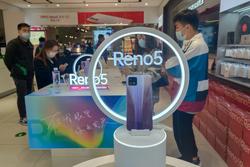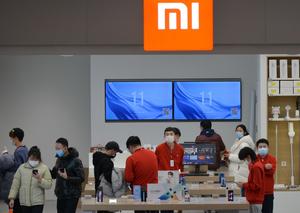 Customers shop for Oppo phones at a store in Shanghai on Feb 7. (WANG GANG / FOR CHINA DAILY)
Customers shop for Oppo phones at a store in Shanghai on Feb 7. (WANG GANG / FOR CHINA DAILY)
The global smartphone market is likely to see a shake-up and rise in 2021 as consumers get ready to embrace 5G-powered smartphones and Huawei Technologies Co continues its struggle with some overseas restrictions, leaving space for competitors, said experts and company executives.
The comments came after global smartphone shipments rebounded in the fourth quarter of 2020 and a clear shift is taking place among leading global smartphone vendors.
Xiang Ligang, director-general of the Information Consumption Alliance, a telecom industry association, said the global smartphone sector has been relatively stable for the past two to three years as the market was saturated and consumers less frequently upgraded their devices. Market positions of top smartphone vendors remained barely unchanged.
But starting from the second half of 2020, competition in the international smartphone arena has intensified, and the market became more dynamic after consumer enthusiasm for 5G smartphones was ignited, Xiang said.
"This year is likely to see a greater shift in the global smartphone market, with uncertainties revolving around how the United States will further deal with Huawei and how other smartphone vendors grab the opportunity to grow their presence," he added.
Such changes were already reflected in the latest rankings of global smartphone vendors. In the fourth quarter, Apple overtook Samsung as the largest smartphone vendor with a record performance. By comparison, in the third quarter Apple was barely ranked fourth globally.
ALSO READ: China's smartphone shipments rebound to pre-virus levels in Jan
Specifically, from October to December, Apple delivered 90.1 million smartphones driven by the success of the iPhone 12 series. This marked the highest shipment volume from a vendor in a single quarter and resulted in a 23.4 percent market share and 22.2 percent year-on-year growth, said market research company International Data Corp (IDC).
During the same period, Xiaomi Corp maintained its third spot with a 32 percent year-on-year surge in smartphone shipments. Oppo climbed to fourth place with a 10.7 percent year-on-year growth, IDC added.
They are eating into Huawei's market share, which fell to fifth place globally with a 42 percent year-on-year decline in shipments. In comparison, two quarters ago, Huawei was the largest smartphone vendor in the world.
 Customers try Huawei Mate 40 series phones at a store in Shanghai on Oct 23. (ZHAI HUIYONG / FOR CHINA DAILY)
Customers try Huawei Mate 40 series phones at a store in Shanghai on Oct 23. (ZHAI HUIYONG / FOR CHINA DAILY)
Separate research from Canalys revealed an even grimmer picture for Huawei. From October to December, the Chinese tech company came in sixth place, marking the first time in six years that it fell outside the global top five smartphone vendors.
There are a lot of elements at play that are fueling the smartphone market recovery - pent-up demand, continued supply push on 5G, aggressive promotions and the popularity of low to mid-priced phones.
Nabila Popal, research director with market research company International Data Corp's worldwide mobile device trackers
Amber Liu, research analyst at Canalys, said, "Huawei dramatically receded in most markets as a result of US sanctions."
Liu pointed to Huawei's decision to divest its Honor device brand. Honor is not bound by the same restrictions and component supplies are resuming. But Honor has a colossal challenge ahead. It needs to redefine the brand to appeal to both premium customers and the mass market. It needs to extend its product range to compare to the original breadth of Huawei.
"And most importantly, it needs to reenter channels that are already signing multiyear deals with competitors. For example, in critical channels like European network operators, the vendor onboarding process can take more than six months. For this reason, Honor is not expected to reclaim substantial market share in the near term," she added.
Sensing the market void resulting from Huawei's challenges, international peers Apple and Samsung, as well as domestic brands Oppo, Vivo and Xiaomi, are working hard to increase their appeal among consumers.
Apple's iPhone 12, for instance, proved to be a big hit. Vincent Thielke, analyst at Canalys, said: "Apple is better positioned than its competitors on 5G, being heavily skewed toward developed markets and mobile operator sales channels. But it also made savvy moves behind the scenes to propel its sales and profitability."
Thielke said the omission of a power plug from the iPhone retail box, which reduces weight and size, is making logistics significantly more efficient amid the ongoing high cost of airfreight due to the COVID-19 pandemic. And it also implemented channel-centric growth initiatives to target small and medium-sized business customers, which bolstered demand for its entire range of iPhones.
Chen Mingyong, CEO of Oppo, also said in a New Year message that it was eyeing a bigger presence in the high-end smartphone segment in 2021, after recording an impressive growth last year.
Chen said Oppo saw a satisfying growth in 2020 despite headwinds such as the challenges from the pandemic.
In other parts of Asia, Oppo maintained its leading position in the smartphone market. In India, as the company expanded local sales, its brand preference among local consumers rose by 33 percent.
In Western Europe and Japan, Oppo's shipments of smartphones more than doubled. All these expansions have helped Oppo grow the number of users of its operating system ColorOS close to 400 million on a global scale, Chen said.
 People shop for Xiaomi products at a store in Shenyang, Liaoning province, on Dec 24. (YAN BO / FOR CHINA DAILY)
People shop for Xiaomi products at a store in Shenyang, Liaoning province, on Dec 24. (YAN BO / FOR CHINA DAILY)
Oppo is not alone. Smartphone vendors including Realme, Vivo and Xiaomi are intensifying efforts to grab a bigger share in the global smartphone market amid Huawei's overseas challenges.
ALSO READ: Huawei, Apple gain bigger share of China smartphone market
Li Bingzhong, CEO of Realme, a fast-growing Chinese smartphone brand, said, "We will open more than 100 offline stores in India and Southeast Asia this year as part of our broader plan to open more than 1,000 stores globally."
Launched in 2018, Realme chiefly relies on its popularity in e-commerce sales channels and its resonance with young consumers.
Li said Realme had entered just 35 markets at the start of 2020, but the figure jumped to 61 by year-end as the company fully leveraged its advantages in e-commerce and other marketing resources.
The recovery of the global smartphone market from the COVID-19 impact is also expected to fuel competition. In the fourth quarter, the world smartphone sector grew 4.3 percent year-on-year in shipments, data from IDC show.
Nabila Popal, research director with IDC's worldwide mobile device trackers, said: "There are a lot of elements at play that are fueling the smartphone market recovery-pent-up demand, continued supply push on 5G, aggressive promotions and the popularity of low to mid-priced phones.
"Vendors also seem to be better prepared for the second lockdown, ensuring they have the right channel set up ready to fulfill orders and reach the end consumer. Lockdowns also have people spending less on areas like leisure, travel and dining out-and smartphones are benefiting from this. In addition to all these factors, the fast recovery and resilience of the smartphone supply chain also has to be given some credit."
IDC added that the recovery of both the smartphone market and its supply chain has been truly impressive and the year-end growth is testament to how far the industry has come and highlights the importance of smartphones in everyday life.
Market research company Gartner Inc forecast that worldwide sales of smartphones will total 1.5 billion units in 2021, an 11.4 percent growth year-over-year.
Anshul Gupta, senior research director at Gartner, said: "In 2020, consumers reduced spending on smartphones but availability of new products will see users drive significant uptick in demand in 2021. The combination of delayed smartphone replacements and the availability of lower end 5G smartphones are poised to increase smartphone sales in 2021."
Gupta added that Gartner analysts expect smartphone sales in 2021 to be close to 2019 levels.
Fu Liang, an independent analyst who has been following the telecom sector for more than a decade, said that this year the global smartphone market will have more vitality.
READ MORE: Remote Derung embraces 5G for inclusive benefits
"It will be a year of high importance to determine vendors' position in the 5G era. As Huawei recedes, consumers and channels are exposed to more choices, while newer or smaller brands have more chances to stand out. The market will be ready to embrace a long period of shake-up in the coming year," Fu said.


